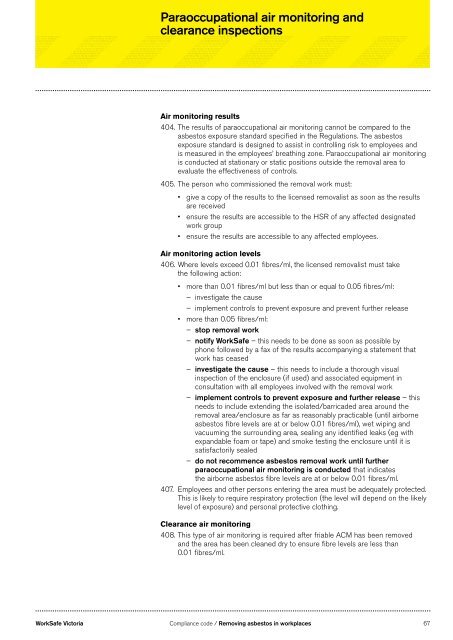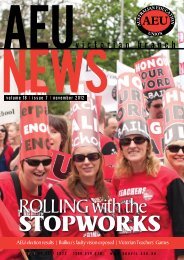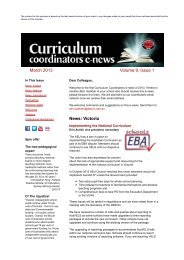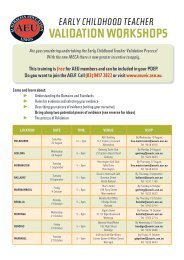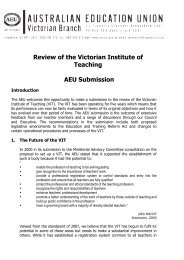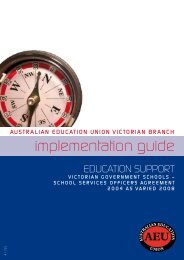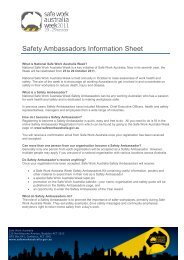Removing asbestos in workplaces - Compliance ... - WorkSafe Victoria
Removing asbestos in workplaces - Compliance ... - WorkSafe Victoria
Removing asbestos in workplaces - Compliance ... - WorkSafe Victoria
Create successful ePaper yourself
Turn your PDF publications into a flip-book with our unique Google optimized e-Paper software.
Paraoccupational air monitor<strong>in</strong>g andclearance <strong>in</strong>spectionsAir monitor<strong>in</strong>g results404. The results of paraoccupational air monitor<strong>in</strong>g cannot be compared to the<strong>asbestos</strong> exposure standard specified <strong>in</strong> the Regulations. The <strong>asbestos</strong>exposure standard is designed to assist <strong>in</strong> controll<strong>in</strong>g risk to employees andis measured <strong>in</strong> the employees’ breath<strong>in</strong>g zone. Paraoccupational air monitor<strong>in</strong>gis conducted at stationary or static positions outside the removal area toevaluate the effectiveness of controls.405. The person who commissioned the removal work must:• give a copy of the results to the licensed removalist as soon as the resultsare received• ensure the results are accessible to the HSR of any affected designatedwork group• ensure the results are accessible to any affected employees.Air monitor<strong>in</strong>g action levels406. Where levels exceed 0.01 fibres/ml, the licensed removalist must takethe follow<strong>in</strong>g action:• more than 0.01 fibres/ml but less than or equal to 0.05 fibres/ml:– <strong>in</strong>vestigate the cause– implement controls to prevent exposure and prevent further release• more than 0.05 fibres/ml:– stop removal work– notify <strong>WorkSafe</strong> – this needs to be done as soon as possible byphone followed by a fax of the results accompany<strong>in</strong>g a statement thatwork has ceased– <strong>in</strong>vestigate the cause – this needs to <strong>in</strong>clude a thorough visual<strong>in</strong>spection of the enclosure (if used) and associated equipment <strong>in</strong>consultation with all employees <strong>in</strong>volved with the removal work– implement controls to prevent exposure and further release – thisneeds to <strong>in</strong>clude extend<strong>in</strong>g the isolated/barricaded area around theremoval area/enclosure as far as reasonably practicable (until airborne<strong>asbestos</strong> fibre levels are at or below 0.01 fibres/ml), wet wip<strong>in</strong>g andvacuum<strong>in</strong>g the surround<strong>in</strong>g area, seal<strong>in</strong>g any identified leaks (eg withexpandable foam or tape) and smoke test<strong>in</strong>g the enclosure until it issatisfactorily sealed– do not recommence <strong>asbestos</strong> removal work until furtherparaoccupational air monitor<strong>in</strong>g is conducted that <strong>in</strong>dicatesthe airborne <strong>asbestos</strong> fibre levels are at or below 0.01 fibres/ml.407. Employees and other persons enter<strong>in</strong>g the area must be adequately protected.This is likely to require respiratory protection (the level will depend on the likelylevel of exposure) and personal protective cloth<strong>in</strong>g.Clearance air monitor<strong>in</strong>g408. This type of air monitor<strong>in</strong>g is required after friable ACM has been removedand the area has been cleaned dry to ensure fibre levels are less than0.01 fibres/ml.<strong>WorkSafe</strong> <strong>Victoria</strong> <strong>Compliance</strong> code / <strong>Remov<strong>in</strong>g</strong> <strong>asbestos</strong> <strong>in</strong> <strong>workplaces</strong> 67


